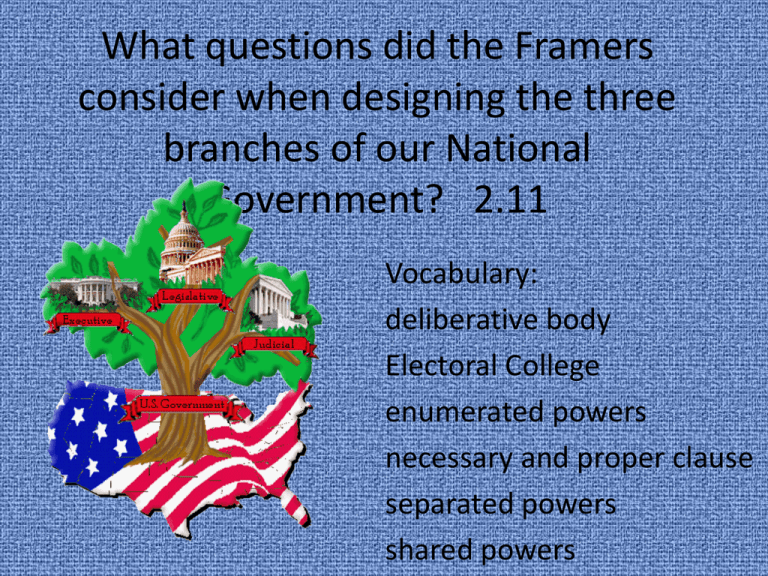What questions did the Framers consider when designing the three
advertisement

What questions did the Framers consider when designing the three branches of our National Government? 2.11 Vocabulary: deliberative body Electoral College enumerated powers necessary and proper clause separated powers shared powers What did the delegates think of the balance of power among the branches of government? • Founders did not want executive offices to hold too much power (like in Parliament) • Did not want weak executives that could not check the powers of the state legislatures • They created a government of separate powers (checks and balances) Legislative power • Congress was to be a deliberative body. Debating issues rather than deciding in haste • Bicameral limited reckless law passing (DUI debate under influence) • Great Compromise=enumerated powers (specific, most found in Article 1 Sec.8) • Congress give the right to make laws that are “necessary and proper” (Art.1 Sec.8 PP18) • http://www.youtube.com/watch?v=CF3OGsaqwp8 Executive Branch • A o C did not provide for Executive branch, but one was needed for foreign affairs, public peace, and treasury management • Framers wanted Executive to be strong enough to be independent and to fulfill duties and to have ‘energy’ to act quickly (military) • Executive was considered after Congress design was completed Balancing the Executive and Legislative • Key Questions: – One or more Chief executives? • One avoids conflict easier to watch, more would be less Tyrannical – How long should Executive remain in office? • Seven years suggested, but four was agreed upon – Should Exec be eligible for reelection? • Seven year term no, four year term yes, no term limit was set at first Selecting a president • Big issue, those who select had a lot of power • General election – For: Fear president selected by congress would lead to corruption and cabal-self serving groups, – Against: Did not want a general election, they thought the people in such a large country would not know the best candidate. George Mason “like entrusting a trail of colors to a blind man” – Many options were explored – Election by states legislatures, state governors, or a temporary elect group • If congress has power than terms must be limited so Congress could not manipulate the president • Congress could neither increase or decrease the salary of the president Committee on Postponed Matters; Electoral College -Article II Sec.2,3,4 • Electoral college assembled once every four years to select president • Each state controlled how the elector’s from their state were chosen • Each state would have the same number of electors as House and Senate members (benefits Great Compromise and 3/5ths) • Each Elector voted for two people, one had to be from a different state • Most votes-president, runner up-VP • House of Reps was tie-breaker, one vote per state Judicial Branch • Judicial needed to decide cases involving its laws • Completes separation of powers • Judges are chosen by president and appointed by congress • Criminal trials should be trial by jury • Judges should be free of political pressures • Hold office as long as not involved in treason, bribery, or other high crimes and misdemeanors Create a Flow chart • How are powers shared among the three branches? • Create a chart that demonstrates these policies











